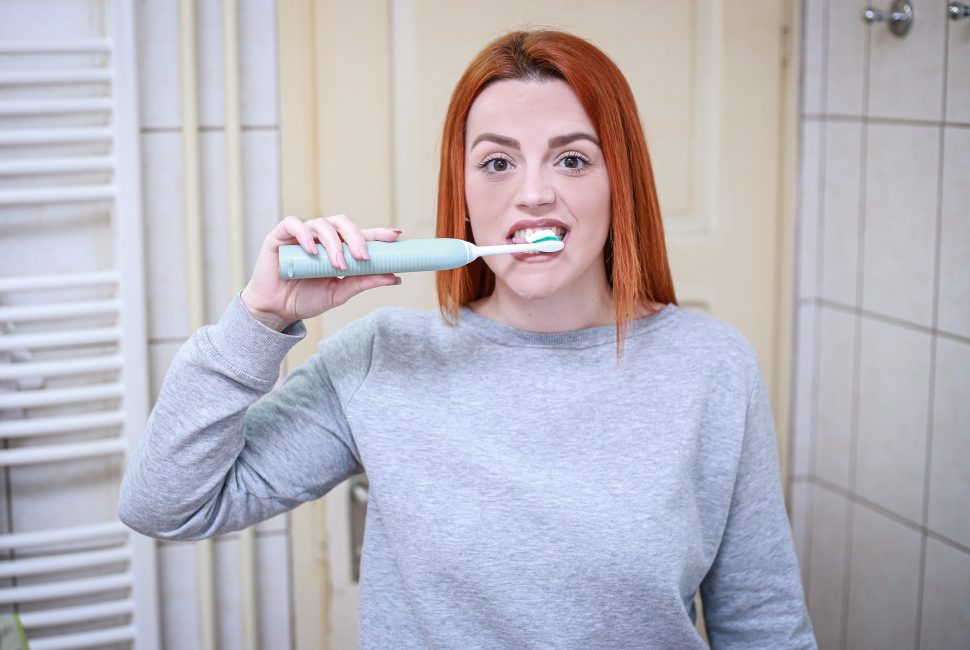How To Clean Your Teeth Properly: 16 Ways To Healthy Teeth & Gums

Keeping your teeth healthy may seem simple enough, we’ve been doing it since we were children, right? Sure, but we are here to dispel some myths and let you in on some secrets to keeping your teeth, gums and mouth healthy & clean well into old age.
How to Keep Your Teeth and Gums Healthy
The most basic dental tip for keeping your teeth healthy and gums healthy is brushing twice daily. Once in the morning after breakfast and once in the evening before bed. Skipping brushing your teeth before going to bed will allow the plaque accumulated throughout the day to continue to build up while you sleep.
Brushing your teeth removes stray food particles and plaque build-up to avoid tooth decay. There is more to brushing your teeth than you may think. Are you brushing for long enough? Are you using the right toothbrush for your needs? Here are some steps to ensure the way in which you brush your teeth is optimised for a healthy mouth and teeth.
The Proper Teeth Cleaning Technique
Brushing your teeth twice a day for two minutes each time is crucial for maintaining good oral health, but using the proper technique is just as important! Here’s a breakdown of the steps involved:
Brushing technique:
- Divide your mouth into sections: This helps ensure you don’t miss any spots. Divide your mouth into four quadrants: upper right, upper left, lower right, and lower left.
- Time your brushing: As mentioned earlier, make sure you brush your teeth for two minutes. Our pro tip: set the timer on your phone!
- Angle the brush: Hold the brush at a 45-degree angle where the bristles meet the gumline.
- Use gentle strokes: Move the brush in short, back-and-forth motions across each tooth surface, including the gumline. Avoid harsh scrubbing, as this can cause damage.
- Don’t forget the inner surfaces: These areas are often neglected, but they’re just as important to clean. Tilt the brush vertically and use gentle up-and-down strokes for the front teeth and back-and-forth strokes for the rest.
- Clean the chewing surfaces: Brush the tops of your molars using back-and-forth strokes.
- Brush your tongue: Gently brush your tongue to remove bacteria and freshen your breath. Use the same toothpaste or a tongue scraper specifically designed for this purpose.
- Spit and rinse: Rinse your mouth with water to remove any remaining toothpaste or debris.
For an extra boost of cleanliness use a mouthwash containing active ingredients like chlorhexidine or cetylpyridinium chloride, which can help reduce plaque and gingivitis.
How To Floss Your Gums Properly
Don’t forget to floss once a day to remove plaque and food particles from between your teeth and gums. Choose unwaxed or waxed floss depending on your preference. Unwaxed floss slides more easily between teeth, while waxed floss may be easier to grip.
Proper flossing technique:
- Start with about 30 cm of dental floss: Wind most of it around your middle fingers, leaving 5 cm of floss between your thumbs and index fingers for control.
- Slide the floss gently between two teeth: Use a sawing motion to ease it down.
- Curve the floss into a C-shape around the base of each tooth: This ensures you clean both the tooth surface and under the gumline.
- Gently scrape the floss up and down along both sides of the tooth: Don’t force it or snap it. Use a clean section of floss for each space between your teeth.
- Repeat for all your teeth: Don’t forget the back ones!
If your gums bleed at first, don’t be discouraged. This is normal and should stop with regular flossing. However, if the bleeding gums continue, consult your dentist.
16 Tips for Keeping Your Teeth and Gums Healthy and Strong
1) Use The Right Toothbrush
Unless instructed otherwise by your dentist, a soft bristle toothbrush is the safest option. Medium or hard bristles can actually damage the gums and enamel leading to tooth decay or gum disease.
The head of the toothbrush should be small enough to reach the teeth in the back of your mouth or you may get cavities in the hard-to-reach areas. You can use a manual toothbrush or an electric one – the choice is up to you but we recommend going electric.
Keep in mind that toothbrushes need to be replaced every 3 months or when you start to notice the bristles becoming frayed or worn down.
2) Use The Right Toothpaste
If you do not have problems with thinning enamel or sensitive teeth, your toothpaste should contain fluoride as a means of combatting germs and preventing tooth decay. Fluoride is known to create a protective barrier on the surface of the teeth which means that the effects of brushing your teeth last longer.
3) Use The Right Technique
People tend to think the harder they brush the better. This is not true; it is best to be gentle to avoid damaging the gums or tooth enamel. If your toothbrush bristles become worn down quickly it may be a sign that you are brushing your teeth too hard.
If you experience pain and sensitivity, even when brushing your teeth gently, you may be suffering from dental erosion. Learn more in our article: Dental Erosion: Symptoms and Treatment.
With a small amount of toothpaste (about the size of a pea) brush the outer surface of your teeth with strokes up and down. Then brush the outer surface with circular motions. Remember to repeat this for the inside, or the back, of your teeth. Brush the chewing surface of the teeth, all the way to the back.
While pointing your toothbrush downwards or at about a 45-degree angle, brush the gum line, or where your teeth and gums meet, repeat on the inner line of your gums and teeth. Before rinsing, remember to brush your tongue.
4) Brush For Long Enough
As we have mentioned, brushing too hard can actually be detrimental. The same is true of brushing too often or for too long. If you are looking to improve the health of your teeth you should be brushing for a minimum of 2 minutes but no longer than 5 minutes. 3 minutes tends to be the perfect amount of time to fulfil the right technique for brushing teeth as described in point number 3.
5) Brush Your Tongue
Brushing your tongue every time you brush your teeth is essential to keeping your teeth healthy and also your overall oral health. If for any reason you do not like brushing your tongue with your toothbrush there are specialised tongue scrapers on the market to complete this oral hygiene task.

6) Don’t Rinse Out Toothpaste Immediately
There is no need to rinse out all of the toothpaste once you have finished brushing. All you need to do is spit out any excess toothpaste. Do not rinse your mouth out with water or use mouthwash directly after brushing.
This washes away the fluoride in the toothpaste covering your teeth which drastically reduces its protective properties and minimises the positive effects on your dental hygiene.
7) Clean Your Toothbrush
Cleaning your toothbrush is imperative to oral health because you use it twice a day. The best way to disinfect your toothbrush is to put it in some antibacterial mouthwash for at least 30 seconds. If you don’t have mouthwash, a cup of water with 2 teaspoons of baking soda will do the same job in about 15 minutes. For a deep clean you can soak your toothbrush in white vinegar for 15 minutes once a week.
8) Floss
This cannot be highlighted enough. Even if you are following all of the steps mentioned above, if you are not flossing you are neglecting all of the gaps between your teeth. That’s a huge portion of your mouth that isn’t being cleaned.
If you currently have braces read How to Brush Your Teeth with Braces: A Guide to Keeping Your Braces Clean.
9) Add Mineral and Vitamin-Rich Food to Your Diet
Strengthening your teeth starts from the inside out. Your diet is the easiest way to effectively remineralise and in turn make your teeth stronger. Make sure your diet is rich in the following nutrients:
- Calcium
- Vitamin A
- Vitamin C
- Vitamin K
- Potassium
- Phosphorus
- Magnesium
10) Cut Refined Sugar From Your Diet
Oral bacteria thrive on sugar. An excessive amount of sugar in your foods and drinks creates acids that dissolve the tooth enamel via demineralisation. This allows cavities to form and can lead to tooth decay or even losing teeth.
11) Prioritise Gut Health
Gut health influences almost all processes in the body. Some probiotics are known to prevent periodontitis and tooth decay. Probiotics also reduce heartburn. If you suffer from heartburn, these acids are not only causing discomfort but can eat away at your tooth enamel.
12) Stay Hydrated
Saliva is actually your first line of defence when it comes to protecting your teeth. If you are dehydrated your body will not produce enough saliva to protect your teeth. Saliva actively protects your teeth while washing away food. Make sure you are drinking plenty of water to ensure your saliva is performing optimally to protect and strengthen your teeth.
13) Stop Grinding Your Teeth
Bruxism, otherwise known as grinding and clenching your teeth is common among children and adults. It can be a symptom of stress or a sign of a bite or tooth malalignment. This can quickly be determined by an orthodontic consultation.
14) Oil Pulling
Oil pulling is the practice of swishing a cold-pressed oil (sunflower, sesame or coconut oil) in your mouth for 10-20 minutes before spitting it out. Done daily, this practice can reduce the presence of harmful bacteria in your mouth.
With the bacteria reduced, you may notice better breath, fewer cavities and reduced inflammation in the gums.
15) Regular Dental Cleanings
The simple fact remains that it is rather difficult to see every corner of your mouth yourself. This is why dental professionals will reduce any sign of gum disease you may have missed while providing a thorough cleaning of your whole mouth.
16) Quit Smoking
One of the most nefarious and common causes of gum disease is smoking and the use of tobacco products. The good news is that your gum health can bounce back once you stop smoking.
Conclusion
The road to getting healthy teeth and gums is well within reach. Simply follow good oral hygiene practices and consult with your orthodontist on how you can keep your smile bright and shining!


